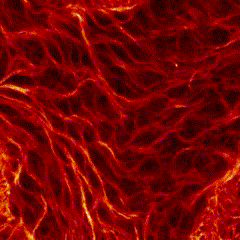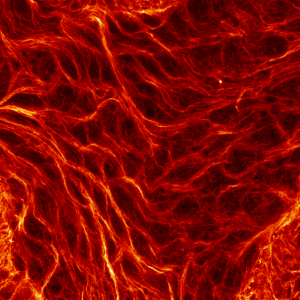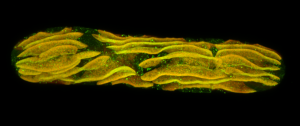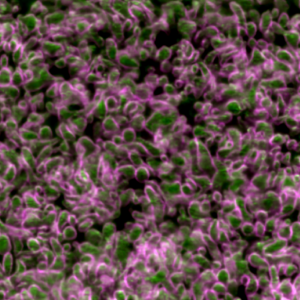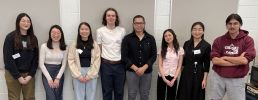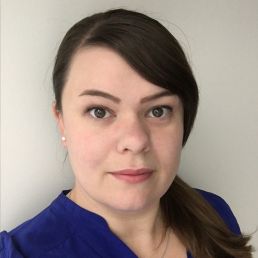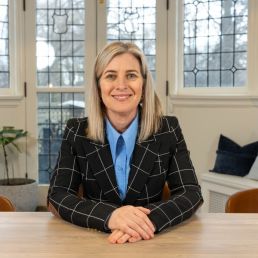Gorgeous images win Nikon Small World Toronto competition
The winners of the Nikon Small World Toronto imaging competition have been announced!
We are proud that the top three winners as determined by imaging facility managers at SickKids Hospital were from Cell & Systems Biology! These images exploited the newest Nikon AXR NSPARC point-scanning confocal microscopy technology.
First place went to Damo Shi for “Immunofluorescence image of microtubules in the amnioserosa of fog-mutant Drosophila embryos”.
Second place went to Emily Deng for “From water to land: green algae transformed with an Arabidopsis protein required for chloroplast biogenesis”.
Third place went to Rebecca Tam for “Highly folded plasma membrane”.
You can see the full images in our gallery.
Shi’s research with Tirthankar Ray in the Harris lab showed that the amnioserosa of fruit fly embryos is confined by surrounding tissue to form a nematic, or crystal-like, structure.
Shi says that “My image for the competition submission was taken from an embryo with mutations of the gene fog, which perturbs confinement and causes reduced amnioserosa cell alignment.” Instead of aligning to outline crystal shapes, the red-stained microtubules in the fog mutant form stormy streaks.
Tam’s image shows a fluffy plasma membrane surface, contrasting with the usual image of the plasma membrane as a flat plane. This image comes from studies in early stage Drosophila embryos of how Arp2/3 proteins regulates cortical tension through patterning of myosin that is integrated with highly folded plasma membrane. In this image, the plasma membrane is coloured green and myosin is magenta.
Tam has shown how the plasma membrane is pulled by the centrosome to form a cap as fruit fly embryo cells divide, and this image shows the folding that occurs at a subsequent stage in the development of the Drosophila embryo. Tam recently won the Christine Hone-Buske award for her research.
Excellence in research shown at end-of-year poster session for undergraduate projects
Students in CSB497, CSB498, and CSB499 presented posters describing their 2024-2025 research projects at the end-of-year CSB Undergraduate Poster Session. Posters were assessed by judges from the Department and eight students earned the F Michael Barrett Award for their excellent presentations. The winners were presented with their awards by Undergraduate Chair Prof Dinesh Christendat.
Students studying model animal systems studied the role of growth factors in stem cells, the effect of radiotherapy on tissue, and made discoveries in gene regulation at the level of both DNA and proteins.
Cindy Yu Fei Lei (Gilbert Lab) won for "In Vitro Characterization of FGF2 as a Muscle Stem Cell Niche Occupancy Modulator"
Caitlin Hui Xarn Tan (Yip lab) presented her results on "Exploring the Role of Tet2 Chip Mutation in the Development of Radiation-Induced Fibrosis"
Yaqing Zhao (Mitchell lab) revealed her insights into "Using Synthetic Transcription Factor Libraries to Decipher the Enhancer Code"
Grace Huang-Zhan (Saltzman lab) was recognized for her "Characterization of the Developmental Delay in C. elegans Polycomb Repressive Complex 1 Mutants"
Undergraduate plant scientists revealed their insights into plant immune responses at the transcriptional and organismal level, as well as probing biochemical regulation of stress responses.
Wan Ni Chow (Yoshioka lab) determined the "Temperature Dependence of Direct Antifungal Effects in ISR-Inducing Plant Growth-Promoting Rhizobacteria"
Reid William James (Yoshioka lab) detailed their work "Investigating the Transcriptional Network within the Cyclic Nucleotide-Gated Channels (CNGCs) in Arabidopsis thaliana"
Vy-nhan Chanh Nguyen (Nambara lab) was recognized for "Unravelling the Regulatory Mechanism of ABA Catabolism Under High Humidity in Arabidopsis Thaliana"
Nicholas Garcia (Guttman lab) presented his work on unique transcriptomic responses evoked by PtoDC3000 Type 3 Secretion Effectors in Arabidopsis thaliana
Congratulations to these winners, and to all poster presenters for their hard work! Thank you to Melissa Casco and Genna Zunde for their hard work organizing the poster session.
Rising star in plant sciences Heather McFarlane awarded CSMB New Investigator Award
CSB Professor Heather McFarlane has earned the prestigious New Investigator Award from the Canadian Society for Molecular Biosciences (CSMB).
The CSMB grants this award to rising stars in cell and molecular biology and this award recognizes McFarlane's outstanding research on plant cell wall synthesis. Plant cell walls provide structure and flexibility to plants that allow them to form thin, flexible structures like corn stalks or trees.
Stress on plant cell walls, including stress from climate change, can reduce yields in important products like lumber, cotton and fuel crops. Previous attempts to modify plant cell walls for improved materials or biofuels have resulted in substantially reduced crop yields, showing that we don't fully understand how this economically important process occurs.
The goal of McFarlane’s award-winning research is therefore to study how plants sense and respond to cell wall changes to permit cell wall engineering that advances sustainability and yields innovative products. McFarlane and her trainees have already revealed important aspects of cell wall synthesis.
They have identified dozens of new molecular components of cell wall signaling and provided mechanistic insights into why some cell wall modifications are tolerated by plants while other changes can cause dramatic growth and developmental phenotypes. We look forward to further revolutionary work from this team.
McFarlane's excellence is reflected by her post as CRC Chair in Plant Cell Biology, by her Ontario Early Researcher Award and by her earning the Dorothy Shoichet Women Faculty in Science Award of Excellence.
Congratulations, Heather!
Congratulations to Professor Woodin on her appointment as President of University of Toronto
Professor Melanie Woodin, an internationally recognized neuroscientist at CSB, has been named the University of Toronto’s 17th president!
An accomplished leader, Woodin is current Dean of Arts & Science at U of T, president of the Canadian Association for Neuroscience and serves on the board of directors at the Vector Institute.
Woodin's Lab at CSB is focused on discovering the cellular mechanisms underlying inhibitory GABAergic synaptic plasticity in the healthy and diseased brain.
They employ a multi-disciplinary approach combining electrophysiology, biochemistry, fluorescence imaging, and behaviour to understand how synapses are built, the mechanisms that underlie their plasticity, and their role in neuronal circuits.
Woodin's studies unravel mechanisms that lead to neurological disorders and diseases, including autism spectrum disorder, Huntington’s disease and ALS.
“I am profoundly honoured to accept this appointment to lead an institution that I care about deeply,” says Woodin. “U of T is widely recognized as one of the world’s best universities and a highly trusted source for ideas, research, innovation and talent.”
Congratulations, Melanie!
Laptop or Lab? Research opportunity in Chang lab leads BCB student to embrace both
A Research Opportunity in the Chang lab led Alena Qin, a student in the Bioinformatics and Computational Biology program, to an appreciation for hands-on experimentation.
Students in Arts & Sciences can engage in research opportunities through the Research Opportunities Program. Qin was accepted into the lab of Professor Belinda Chang, whose lab works on recreating the evolution of visual proteins in the laboratory, using dry-lab computational methods, but also wet-lab mutational studies.
“The ROP has definitely helped me narrow the scope of the type of research I'm interested in,” say Qin. “I’m really enjoying the wet lab experience and I'm thinking of pursuing a career that’s more in line with that.”
You can read more about Qin's experience in "A&S Research Opportunities Program provides second-year undergrad Alena Qin with hands-on lab experience.
ROP courses are posted on CLNx in February when the applications start. You must apply on CLNx within the program application timeframe, which is from mid-February to mid-March every year, to be considered.
For other positions in Cell & Systems Biology, students can review the list of Faculty for labs researching their topics of interest and contact the professors. Not all professors have available positions in their labs, so it's good to contact several professors.
We are glad to offer these research positions to help students learn where their future can take them.
Excellence in Plant Science earns Professor Heather McFarlane the Dorothy Shoichet Award
 Congratulations to CSB Professor Heather McFarlane on earning the Dorothy Shoichet Women Faculty in Science Award of Excellence. McFarlane is receiving the award to support her research into how plants sense and respond to cell wall changes, work that has important applications in the production of renewable bioproducts including paper, cotton, wood, compostable bioplastics and next-generation renewable biofuels.
Congratulations to CSB Professor Heather McFarlane on earning the Dorothy Shoichet Women Faculty in Science Award of Excellence. McFarlane is receiving the award to support her research into how plants sense and respond to cell wall changes, work that has important applications in the production of renewable bioproducts including paper, cotton, wood, compostable bioplastics and next-generation renewable biofuels.
"Heather is a stellar researcher who produces world-class research through ingenuity and thoughtful guidance for trainees in the lab." says Professor Jennifer Mitchell, CSB's Associate Chair, Research. "This award will accelerate the pace of her discoveries by allowing her to devote more time to her research with long term impacts in sustainable agriculture, food security, and next-generation biofuel development."
The Dorothy Shoichet Women Faculty Science Award of Excellence was established in 2016 by University Professor Molly Shoichet in honour of her late mother. It provides release from teaching for early-career, female researchers in any of the physical or life sciences, computer sciences or mathematics within the faculty.
“I'm deeply honoured to receive the Dorothy Shoichet Award,” says McFarlane. “Time is a valuable resource in the lab and this award provides precious time and the opportunity to focus on research and research training. The award will accelerate my lab's research as we pursue several exciting directions in our efforts to understand plant cell-wall signaling."
Congratulations, Prof McFarlane!
Supporting the Talented Women Scientists in CSB on IDWGS
We are proud to recognize the accomplishments of our women colleagues on 2025's International Day of Women & Girls in Science and to offer our support all year long.
This year saw many accomplishments from women scientists at CSB! Follow the links below for more details on some of these achievements:
Professor (and former Chair) Daphne Goring earned a Gold Medal awarded by the Canadian Society of Plant Biologists for a career of outstanding contributions to plant science.
CSB student (now Dr) Sonia Evans resolved the long-standing "pyruvate paradox" in a publication at Nature Plants by discovering the pathway whereby pyruvate is generated from rubisco in the chloroplast. Her outstanding skills earned her a Provost Post-Doctoral Award from UofT.
Professor Heather McFarlane showed how building the economically crucial plant cell wall is dependent on correct labeling of its components in a publication at Development Cell. Her excellence was recognized in the renewal of her Canada Research Chair in Plant Cell Biology.
Teaching Assistants are a vital part of our courses and this year, four women received commendations from life sciences undergraduates for their outstanding skills. Congratulations to Ruby He, Mary-Elizabeth Raymond, Andrea-Aditi Taylor and Kathryn McTavish on your TA Teaching Excellence Awards!
CSB is committed to leadership and innovation in research and teaching. We incorporate equity, diversity, inclusion, and integrity in our operations. We value respect, professionalism, and collaboration in our community. None of this is possible without acknowledgement and support for women and girls in science.
Restoration of Rapid Wound Repair Despite Immunosuppressants
Researchers at U of T have determined that immunosuppressants used with transplant recipients slow wound repair by inhibiting the growth of cells adjacent to wounds. They have found ways to restore rapid wound repair in an in vivo animal model.
Prof Rodrigo Fernandez-Gonzalez in the Institute of Biomedical Engineering studies wound repair in the fruit fly embryo. In humans, wound repair is slowed by the immunosuppressant rapamycin, so Dr Gordana Scepanovic in his lab probed the effect of rapamycin on wound healing focusing on the protein target of rapamycin (TOR).
Scepanovic looked at two processes that happen in wound repair; the edges of the wound must be drawn together like a purse string and at the same time the cells around the wound must swell to take up the missing space from the wound.

Scepanovic found that disrupting TOR signalling with rapamycin did not affect the edges of the wound being drawn together. Instead, disrupting TOR prevented cell swelling and slowed down wound repair. Scepanovic used live microscopy and quantitative image analysis to measure wound healing dynamics and cell swelling.
In the absence of a wound, cells constantly digest and recycle small internal particles called lysosomes in a process known as autophagy. Scepanovic found that with normal TOR signalling autophagy was turned down upon wounding. Disrupting TOR signalling caused autophagy to go ahead at its normal level, inducing the cell to consume the materials that should have been used to swell the cell.
Rodrigo Fernandez-Gonzalez recognized the importance of this research from talks with colleagues at the Ted Rogers Centre for Heart Research. “When we first moved here, heart clinicians told me that surgical patients who were treated with rapamycin have difficulty healing their wounds.
“Immunosuppressants are important to prevent rejection of transplants, but transplant recipients sustain a wound from the surgical procedure, and this wound must heal rapidly to prevent infection. So how can we reactivate wound healing even in the presence of immunosuppressants?”
Fernandez-Gonzalez’ lab was able to return rapamycin-inhibited wound repair to normal levels by reducing the levels of proteins related to autophagy using RNA interference in their fly embryos.
They also saw promising results in inhibiting autophagy using the drug bafilomycin, which is known to inhibit maturation of lysosomes into autophagosomes.
The researchers’ detailed analysis of the downstream effects of the immunosuppressant rapamycin on wound healing show promise for applications to improve transplant efficacy.
These important results have been published in the journal Developmental Cell as “mTor limits autophagy to facilitate cell volume expansion and rapid wound repair in Drosophila embryos”.
New tools give an AI boost to plant scientists at the BAR
Huge amounts of biological data generated from plant genomes can now be more rapidly assessed alongside literature describing plant genes thanks to new tools developed by CSB and CS researchers.
Prof. Nicholas Provart founded the globally recognized Bio-Analytic Resource (BAR) server 20 years ago when he recognized the need to collate plant molecular data and provide clear visual summaries for researchers’ queries. Up to now, users had to apply their own interpretations to the data, but Provart and his team have added a new layer to the BAR, designated Gaia.
Gaia collates the interpretations of those who generated the data, summarizing the derived gene models and gene annotation using the latest techniques in machine learning and generative AI.
This curated and processed collection was judged important enough to be included in the Web Server issue of Nucleic Acids Research as “20 years of the Bio-Analytic Resource for Plant Biology”.
Alex Sullivan built the Gaia module for BAR based on data processed by Michael Lombardo, Emma Zhuang, and Ashley Christendat.
Provart acknowledges that “We were dependent on the open science movement, which freely provides all data in a clearly organized manner. Because of this initiative, Gaia can produce high quality, user-friendly output.”
Lombardo developed the GeneNet machine learning method to identify genetic model figures in 67,291 Arabidopsis papers from the PubMed Central database at the NIH.
GeneNet scans journal graphics to determine which figures are likely genetic models using a classification network with a success rate of around 95% (some positive figures are protein-protein interaction networks, not genetic models).
Optical Character Recognition was then used to pull out all the genes mentioned in the figures, which are aggregated to link them in the Gaia database.
 As part of their undergraduate projects, Christendat and Zhuang used generative AI to analyze entries in the Singapore-based PlantConnectome, a GPT 3.5-based summary of >100k Arabidopsis abstracts linked on a gene-by-gene basis across publications.
As part of their undergraduate projects, Christendat and Zhuang used generative AI to analyze entries in the Singapore-based PlantConnectome, a GPT 3.5-based summary of >100k Arabidopsis abstracts linked on a gene-by-gene basis across publications.
Crucially, PlantConnectome maintained the association between extracted information and the paper that the information was derived from by submitting abstracts one-by-one for summarization.
Christendat and Zhuang took this machine-readable database and used skillful prompt engineering through the Llama3 LLM to format the data into a human readable form.
Llama3 was only usable with modifications made by the team. One of their challenges was to ensure the correct journal references were included in each summary.
“It was fascinating to apply my skills to extract meaningful biological data using the latest technology,” enthuses Christendat, a 3rd year student in Computer Science.
BAR is recognized as a Global Core Biodata Resource with two decades of reliable operation through continuous improvements and additions. This new addition shows that BAR will continue to thrive and advance plant science for years to come.
Nambara lab reveals plants' exquisitely tuned responses to high humidity
CSB plant scientists have identified the finely tuned way plants adjust to high humidity conditions. Canadian crops will experience high humidity conditions more often due to increased rainfall and flooding, which enhances the importance of these insights. Professor Eiji Nambara led this research as part of his studies on the ways plants integrate signals of stress in their environment, like drought, pathogens or cold.
Nambara is originally from East Asia, where excess water environments occur frequently in a climate heavily influenced by the ocean. Rice is anatomically shaped to handle excess water such as floods, but wheat crops or the model plant Arabidopsis are adapted to a more temperate climate.
Research by Saad Hussain in Nambara's lab showed that exposing Arabidopsis to high humidity resulted in catabolization of the plant hormone ABA by the ABA-8’hydroxylase enzyme CYP707A3.
He traced the pathway from early high humidity signaling to the decrease of ABA, which facilitates transpiration. Their bioinformatic analysis found that proteins associated with calcium ion signaling were initially activated.
Focusing on calcium, they made an unexpected discovery. When they looked at their plants to see how quickly they responded to high humidity, they saw a glowing calcium signal within a few minutes!
This rapid signal appeared around the periphery of the leaf, near regions called hydathodes. The hydathode is a pore that opens as a relief valve to drain condensed water from the leaf, which helps the plant control water levels in high humidity.
A potential drawback of this response is that bacteria thrive in a humid environment and can infect plants by invading the leaf through the open pore.
Plants have evolved to manage these tradeoffs. Hussain’s results in collaboration with the Yoshioka lab show that high humidity triggering calcium influx into the cytosol goes on to activate ABA catabolism, which in turn induces plant immunity genes. So even though stomatal pores open to increase evaporation under high humidity, the plant is protected from infection.
The plant’s highly tuned regulatory pathways mean that cytosolic calcium concentration can induce opposite responses using same regulatory modules, depending on the input signals. ABA plays a role in cold response, but calcium channels responsible for high humidity responses were activated selectively while cold-responsive calcium channels were unaffected.
This insightful research addressing potential responses to the effects of climate change has been published by the journal PNAS as “Calcium signaling triggers early high humidity responses in Arabidopsis thaliana”.

